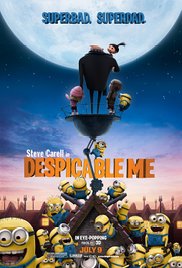 Universal has balls of steel for naming their first foray into the world of computer animation “Despicable Me.” In truth, it’s not the best title from a marketing perspective, since it doesn’t tell you anything about the movie, certainly not in comparison to, say, “Toy Story,” “The Princess and the Frog” or “Finding Nemo.” Yet “Despicable Me” is the perfect title for this delightfully silly movie, because it sends a clear message up front that this is not your typical animated adventure. Sure, it has the traditional, sweet moral (being there for your kids is more important than anything you’ll ever do at work), but it also derives laughs out of dream sequences where a grown man joyfully abandons three small children.
Universal has balls of steel for naming their first foray into the world of computer animation “Despicable Me.” In truth, it’s not the best title from a marketing perspective, since it doesn’t tell you anything about the movie, certainly not in comparison to, say, “Toy Story,” “The Princess and the Frog” or “Finding Nemo.” Yet “Despicable Me” is the perfect title for this delightfully silly movie, because it sends a clear message up front that this is not your typical animated adventure. Sure, it has the traditional, sweet moral (being there for your kids is more important than anything you’ll ever do at work), but it also derives laughs out of dream sequences where a grown man joyfully abandons three small children.
Gru (Steve Carell), a Russian criminal mastermind, has hit a bit of bad luck. He hasn’t pulled off a truly diabolical crime in a while, and the bank that funds his work is threatening to cut him off. He has a plan to steal the moon, but for it to work, he needs a top-secret shrink ray. When the ray is stolen by a younger villain named Vector (Jason Segel), Gru devises a plan to use three orphan girls selling Girl Scout cookies to enter Vector’s house and inadvertently assist him in procuring the device. But in order to use the girls, he needs to adopt them, even though he hasn’t the foggiest idea how to take care of or even talk to children. As he spends more time with them, he loses sight of his evil scheme, much to the dismay of both the bank and his staff scientist Dr. Nefario (Russell Brand).
In basic form, the movie is a bit like “Shrek,” in that the lead is an anti-social grouch who’s ultimately healed by love. The similarities end there, though, as “Despicable Me” draws inspiration from Tex Avery cartoons and the “Spy vs. Spy” series from “Mad Magazine,” right down to Gru’s long, pointy nose. And with “Spy vs. Spy” comes a healthy dose of mean, though the movie is smart to keep things mean but not mean-spirited. Perhaps the most impressive thing about “Despicable Me” is the decision to have the voice actors playing characters, rather than themselves. Brand’s Dr. Nefario has an English accent, yes, but it’s not Brand’s accent, and Vector sounds very little like Segel’s normal speaking voice. Carell, as we mentioned, is Russian, and Kristen Wiig, who plays the heartless director of the orphanage, uses a southern drawl. It’s a little thing, but it makes a big difference.
If there is one thing that disrupts the movie, it’s the way in which it rushes towards the inevitable conflict between Gru and the girls in Act III. It’s not at all natural, and one gets the sense that the directors – both of whom are French, which might explain the movie’s unconventional approach – would have preferred to flesh out the bonding stage of the story, but a studio-mandated run time (and a front end-loaded plot) forced them to make some unpleasant decisions in the storyboarding process. The movie is also one giant You Must Suspend Disbelief moment, as Gru and Vector do all sorts of things that should arouse the suspicion of the authorities, yet no one suspects them of any wrongdoing. And yet, it’s never an issue, and that’s the way it should be. When Gru gets even with a crooked carny at an amusement park, it’s hard to argue with his methods.
If “Despicable Me” is any indication of what’s to come from Universal and Illumination Entertainment, they could be in a position to challenge Pixar before too long. They are clearly not afraid to think big, and their willingness to throw caution to the wind actually gives them a leg up on Pixar in some regards. (Pixar is brilliant, yes, but not what one would call wacky.) Better yet, they’ve delivered the best 3D of any movie not named “Avatar” since this silly 3D trend began. This could be the beginning of a beautiful friendship.
 (3.5 / 5)
(3.5 / 5)



